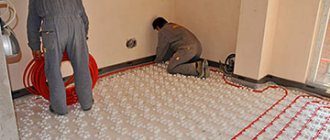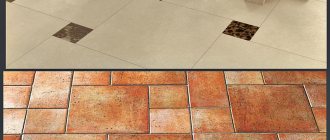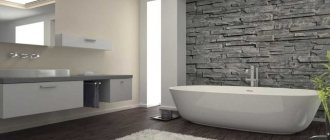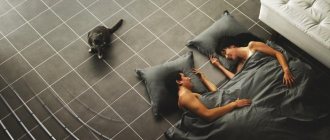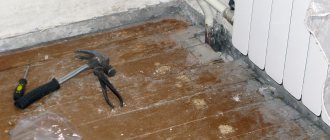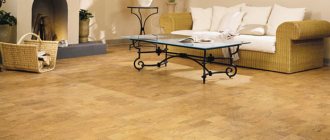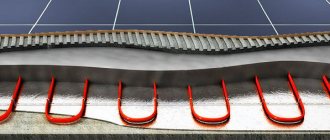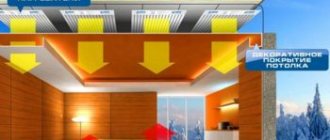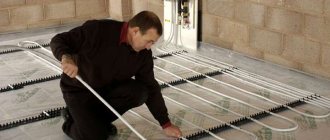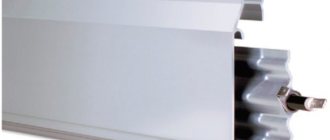0
3149
12.05.2014
Warm heated floors have recently become the de facto standard for constructing heating systems in apartment buildings and private cottages. The use of heated floor systems allows you to create the most comfortable atmosphere in the room.
Underfloor heating - photo
Heating systems in underfloor heating can have different characteristics and operate on different principles. When constructing warm heated floors, you can use any type of finishing floor coverings, thus, a warm heated floor can be installed in a room for any purpose: in a bedroom or in a nursery, in a kitchen or in a bathroom.
A very important element when constructing a heated floor is its substrate. With its help, the efficiency of the heating circuit is greatly increased, be it an electric heating cable, infrared film or pipes with coolant liquid.
Right choice
If the apartment owner intends to connect to the water system, he will have to obtain official permission to do so. This is explained by the fact that it is difficult to accurately control the thermal energy consumption of an individual consumer; moreover, not all boilers are able to withstand a significant increase in energy consumption. We must not forget about the significant cost of installing a heating device in a city apartment.
Electrical systems are divided into cable and film, the latter are also called infrared. They require taking into account the parameters of the existing wiring and the presence of protective fittings. To heat floors effectively, the equipment power must be at least 250 kW per 1 sq. m. If we count in total, we get large figures. Today, manufacturers produce an impressive range of substrates for infrared heated floors, differing in the material of manufacture.
What is a warm film floor
Warm infrared film floors are a heat-resistant polyethylene film in which strips of carbon paste are packed. In turn, the paste is connected by copper bars, which are also soldered into the film.
The entire structure is called IR thermal film. If a current of a certain strength and frequency is supplied through the tires, the carbon elements begin to emit infrared radiation with a wavelength of 5 to 20 microns.
It does not cause heating of the surrounding air and drying it out, as traditional radiators and heaters do. Infrared rays heat surrounding objects - flooring, walls, ceilings, furniture.
It is important to know! It should not be confused with electromagnetic radiation, which has a harmful effect on the human body, animals and plants.
This heating system has virtually no side effects and is environmentally friendly. Scientists from around the world have proven the beneficial effects of infrared rays on living organisms and humans in general.
Infrared heated floor technical characteristics have the following:
The energy consumption of an infrared heated floor directly depends on its area and mode of operation.
On the modern market, many manufacturers present their options for warm film floors. They all have approximately the same characteristics. So which infrared heated floor is best for you to decide.
The thickness of the thermal film is 0.4 mm, which allows it to be installed under any floor covering - ceramic tiles, laminate, parquet boards, linoleum and carpet.
In addition, this film can be installed on walls and ceilings. In this case, heating will occur throughout the entire volume of the room.
Of course, installing infrared heated floors under one or another coating has its own characteristics. For example, to lay a film floor under carpet or linoleum, plywood should be laid on the heating strips.
Important Features
The choice of underlays for heated floors is an important point.
When laying the substrate, it is necessary to connect the joints well
It is necessary to pay attention to the following characteristics:
- Thermal conductivity . The smaller it is, the better the substrate works. This parameter depends on the material of the product and the thickness of the layer. Modern linings have a foil surface layer to improve the effect by reflecting infrared rays. Heat saving parameters can be increased by 30%. The materials used today comply with construction standards.
- Manufacturability . The simpler the materials are to work with, the easier it is to deal with them. Expanded polystyrene is considered to be the most technologically advanced. It produces thin substrates, the thickness of which is rarely more than 5 mm. To cut them, use regular scissors.
- Additional properties . Some products have special protrusions on the surface. There may also be a grid drawn on the front side. These components simplify the process of laying pipes and make it possible to fix them simultaneously with laying. As a result, it is not only possible to speed up the installation of products, but also ensure long-term and stable operation of the system.
In this video you will find out whether penofol is needed under a heated floor screed:
Do you need underlay for heated floors?
Regardless of the choice of the type of heated floor (infrared (IR), water or electric), its structure will necessarily include such constituent elements as a base base, a heater, a substrate and the floor covering itself. If with some “layers” everything is quite clear, then whether a substrate is needed under a warm floor is doubtful among some ordinary people.
In addition to choosing the type of “warm floor” system, it is necessary to correctly select related materials that will effectively prevent heat loss in the room. One of these items is the substrate, which is designed to prevent heat from passing down.
If this is not done, then installing a heated floor will be impractical. In a private house, for example, such a thoughtless and ill-equipped system will partially heat the basement, and in an apartment building - the ceiling of the floor below.
Therefore, it is extremely important to carefully consider not only the perforated or solid backing material, but also its thickness. This will help make more efficient use of the thermal energy generated by the heated floor itself.
In addition to its main function, the substrate also:
- prevents cold air flows, as well as moisture and steam rising from the bottom of a building or room;
- is a kind of corrector for unevenness of the subfloor;
- copes well with isolating extraneous sounds and noise.
Other indicators
No less significant points are environmental safety and the cost of materials. Resin and plastic have the ability to release toxic substances into the air. Safety depends on the concentration of the substances. The requirements for underlays for heated floors are more stringent, since they are used in conditions of elevated temperatures. Heat saving costs can be optimized if special technical knowledge is available.
The substrate can withstand heavy loads
At the same time, there are parameters that do not play a special role when assessing the effectiveness of heated floors. These include the noise absorption rate. Absolutely any materials used in this area do not transmit sound well enough. They create obstacles in front of air flows that facilitate the conduction of sound waves.
Another indicator that is worth paying attention to is waterproofing. Aluminum foil does not allow water or steam to pass through. The question of the need for waterproofing for heating systems is especially significant. When it comes to water systems, quickly detecting leaks will reduce the owner's losses. Accordingly, the structure will be less exposed to high humidity. The situation with electrical systems is much more complicated. Water is not allowed here, as it causes short circuits.
How to choose a underlay for a heated floor:
The ability to withstand ultraviolet rays is necessary when there is a source emitting them or an X-ray machine under the floor. If they are not available, you can buy special products to protect against UV radiation.
Laying linoleum
Linoleum is one of those materials whose installation usually does not pose any particular difficulties. Since we are talking about a roll covering, it needs to be leveled before laying. For these purposes, the material is rolled out indoors and left for several days. If the room has a heated floor, then you need to turn it on: this will speed up the process of leveling the linoleum.
To increase the final quality, it is advisable to lay a heated floor under linoleum on plywood or chipboard. Fixing wood boards must be done very carefully, avoiding damage to the IR film underneath. In this case, an electric cable floor is much more reliable. Linoleum is fixed on top of the plywood using special double-sided tape or glue. If a laminate is used on top of a heated floor, then it is better to install it with glue: this will increase the tightness of the coating and the uniformity of its heating. At the final stage, you need to install skirting boards that hide the system wiring and check the operation of the system again. This will allow you to choose the most suitable temperature regime.
Products with electric heating
The underlay for an electric heated floor is made of pressed cork and plastic foil.
Products with increased thickness are made from extruded polystyrene foam. They have increased physical strength, making them suitable for laying under concrete. The underlay is used for all electrically heated floors, including standard versions. If the base has defects, it must be leveled. In this case, it is permissible to use substrates made of chipboard and OSB. Read also: about the properties of expanded polystyrene.
Polyfoam is another option for the substrate. Here, polyethylene foam is combined with aluminum, paper and metallized film. The sheets are laid in layers close to each other. In areas where moisture can seep in, it is necessary to connect the polyethylene sheets with tape.
You can lay the underfloor heating yourself
An aluminum reflective layer is undesirable for electric floors, since if the insulation is broken, current leakage with negative consequences is possible. The reflective layer is placed on a polyethylene film and equipped with vacuum deposition. When choosing a specific brand, you should take into account factors such as the finishing coating. The lighter it is, the less durable the underfloor heating will be. Extruded materials are used for artificial stone and ceramic tiles.
In this video you will find out whether foil is needed for heated floors:
When installing heated floors during the renovation of old premises, the total thickness of the “pie” ranges from 10 to 15 cm. It depends on the load-bearing floor and floor technology. These parameters are important when designing the height of window and door openings. When renovating, you need to make the floor thinner in advance. Thanks to this, there will be no need to reduce the height of the doors in the future.
It is best to install a warm floor that does not interfere with opening and closing doors. The worst option is to install a system that requires you to raise the lintel of the doorway.
Finish coatings for film heated floors
You can use carpet, linoleum and other soft materials as a finishing coating. The main thing to consider is that the film underneath is easy to damage.
Also keep in mind that cork flooring is a poor conductor of heat. In this regard, laying a heated film floor under this coating is impractical, but possible.
If there is a need to lay heating film under soft coverings, do it in places that will not be subject to heavy loads and damage (wardrobe, armchair, sofa, sectional, etc.).
Ceramic tiles are not very suitable for such a floor. Tile adhesive does not adhere well to film and you will have to use reinforced mesh to hold the adhesive. For tiles it is better to use an electric mat.
The ideal finishing floor covering for a warm film floor is laminate parquet boards.
Quick installation and the absence of specific construction and finishing work, ideal for those who want to install an electric heated floor with their own hands.
How to lay laminate flooring correctly
Laminate is a modern floor covering that is very popular due to its high performance characteristics and ease of installation.
The process of laying laminate flooring includes preparing the base, laying the insulating layer and directly laying the covering. To understand how to properly lay laminate flooring, you need to study and take into account a number of important points. Let's try to understand the nuances of the process.
In order for the floor covering to last as long as possible, certain rules must be followed during installation.
The maximum permissible difference in height for the base on which the laminate is laid is 2 mm per meter.
If the floor is more uneven, it should be leveled. This process differs for each individual flooring option. Laying the flooring on an uneven floor will inevitably lead to premature failure, so try to avoid this.
In addition, the coating cannot be installed on an electrical underfloor heating system. This will lead to drying out and deformation of the panels.
If you really need to have a heating system under the flooring, use the hydraulic option. The hydraulic underfloor heating system distributes heat evenly and does not overheat the coating. Remember that the distance between the lower border of the laminate and the elements of the heating system must be at least 3 cm.
Lining for water floors
At the top of water heated floors there is a cement-sand screed. It is better to use products from:
- sheet plywood;
- OSB;
- extruded polystyrene foam.
This type of substrate is good for use under water-heated floors.
These materials can withstand heavy loads without the effect of residual deformation being observed. The substrate must withstand moisture. If an unexpected leak occurs, the material must be suitable for further use. Of course, leaks are undesirable, but it is better to take measures to prevent them in advance.
It is important to ensure reliable fixation of pipelines, where special substrates with protrusions are offered to simplify the installation process. This ensures the same distance between the pipes along the entire floor plane.

